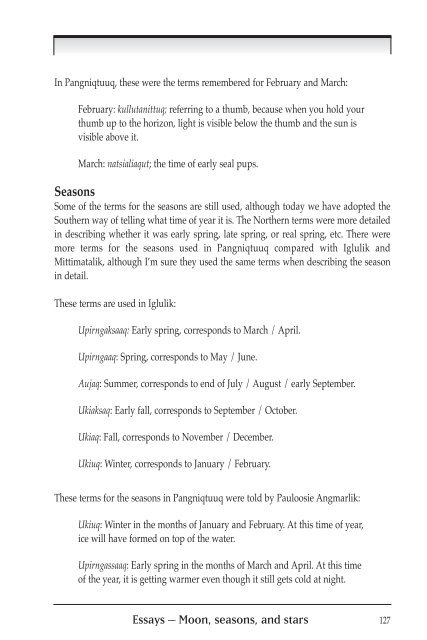Introduction-E
Introduction-E
Introduction-E
Create successful ePaper yourself
Turn your PDF publications into a flip-book with our unique Google optimized e-Paper software.
In Pangniqtuuq, these were the terms remembered for February and March:<br />
February: kullutanittuq; referring to a thumb, because when you hold your<br />
thumb up to the horizon, light is visible below the thumb and the sun is<br />
visible above it.<br />
March: natsialiaqut; the time of early seal pups.<br />
Seasons<br />
Some of the terms for the seasons are still used, although today we have adopted the<br />
Southern way of telling what time of year it is. The Northern terms were more detailed<br />
in describing whether it was early spring, late spring, or real spring, etc. There were<br />
more terms for the seasons used in Pangniqtuuq compared with Iglulik and<br />
Mittimatalik, although I’m sure they used the same terms when describing the season<br />
in detail.<br />
These terms are used in Iglulik:<br />
Upirngaksaaq: Early spring, corresponds to March / April.<br />
Upirngaaq: Spring, corresponds to May / June.<br />
Aujaq: Summer, corresponds to end of July / August / early September.<br />
Ukiaksaq: Early fall, corresponds to September / October.<br />
Ukiaq: Fall, corresponds to November / December.<br />
Ukiuq: Winter, corresponds to January / February.<br />
These terms for the seasons in Pangniqtuuq were told by Pauloosie Angmarlik:<br />
Ukiuq: Winter in the months of January and February. At this time of year,<br />
ice will have formed on top of the water.<br />
Upirngassaaq: Early spring in the months of March and April. At this time<br />
of the year, it is getting warmer even though it still gets cold at night.<br />
Essays – Moon, seasons, and stars 127


